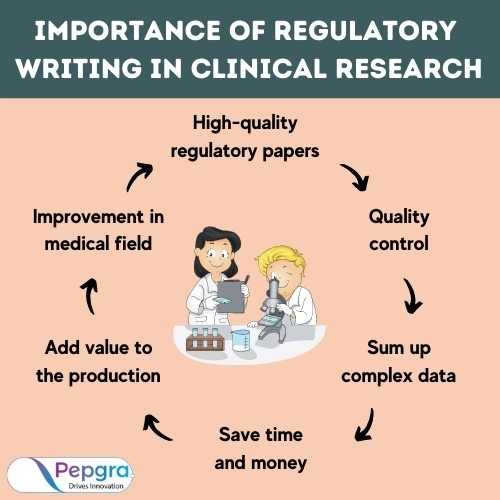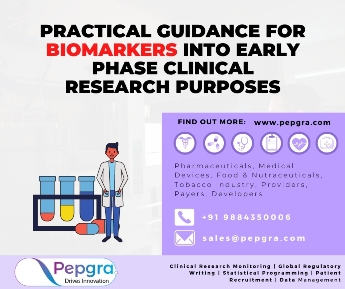In-Brief:
- There are two main parts in medical writing, medical communication and regulatory writing.
- Pepgra blog focuses on regulatory writing, which involves preparing the clinical study and regulatory submission documentation and its importance.
- Regulatory writing is one of the critical factors in the clinical research field and global regulatory service
Introduction:
Regulatory medical writing produces a wide variety of clinical documents during the life‑cycle of treatment, opening with describing and writing data from clinical trials and preparing regulatory suggestion documents. If a regulatory authority accepts the therapy, regulatory writers also produce post-approval reports on patients’ treatment. Examples of clinical documents produced by Medical writing services most commonly include Investigator Brochures (IBs), the Common Technical Document (CTD) Clinical Study Protocols, Clinical Study Reports (CSRs) using regulatory writing services.
Functions of the regulatory writer:
- The clinical writer’s critical capacity is to change the vast amounts of clinical information delivered during clinical preliminaries into accurate, reasonable and agreeable records for accommodation to the pertinent administrative specialists as a feature of the advertising application.
- Data should be introduced plainly and compactly, yet with the reasonable degree of detail to help the accommodation cycle.
- If conceivable, the clinical author ought to use standard layouts to guarantee the harmonization of phrasing and archives across the segment portions of the accommodation.
- Clinical Study Reports are the establishment of most of the administrative entries. The clinical writer may likewise be needed to plan incorporated synopses of wellbeing and viability. Of note, the ISS/ISE are coordinated investigations of the information from the clinical examinations and are for the most part a lot of superior archives than the viability and wellbeing rundowns introduced in Modules 273 and 274.
- Allowing adequate time for the clinical author, related to different individuals from the undertaking group, to design, compose and survey records is at last savvy.
- Documents that are hurried will contain mistakes and exclusions, bringing about inquiries and solicitations for explanation sometime later. It can prompt expensive postponements.
- Compliance with nearby administrative prerequisites ought to be tended toward the beginning of the creative cycle to guarantee that any country’s precise necessities are sufficiently met. For instance, close down, and index prerequisites can fluctuate between nations.
- Writing ought to be a community-oriented cycle. An outside advisor can viably oversee the majority of the work is essential. Contribution from the support as far as the crucial comprehension of the product and the therapeutic zone under assessment is vital to generally speaking achievement.
- The report audit cycle can be hard to control since time is scant and archives complex. Audit courses of events ought to be reachable and concurred already. Report survey gatherings are an effective method to arbitrate remarks to guarantee that all issues raised are talked about, and enough tended to.
- Further down the line, reacting to questions raised by the administrative assessors requires a comparably realistic methodology. Reactions ought to be all around developed, compact and spotlight on the central issues. Additional data should be given where significant, yet the arrangement of colossal measures of additional information ought to stay away from as this will serve to cloud the issues.

Importance of regulatory writing in clinical research
- The importance of preparing high-quality regulatory papers is often assessed. A CSR is the final product of many months and at times years of hard work by education teams, and has to review the conduct and outcomes of a clinical study transparently and impartially.
- A well-written CSR will support the subsequent production of high-quality proposal papers using medical devices writing services. Equally, poorly written or presented controlling documents may lead to interruptions in regulatory support and price the sponsor stage and money.
- In the ever-changing regulatory atmosphere, experienced regulatory writers can add importance to clinical study documentation production.
- As an essential piece of the clinical exploration measure, the administrative writer can go about as a group of information at each progression, from convention improvement to the medication accommodation measure.
- Regulatory scholars are gifted at meeting worldwide administrative prerequisites and holding fast to direction records.
- They comprehend, decipher, and sum up regularly complex logical and measurable information while giving clear direction to clinical examination groups, which for the most part incorporate specialists from different fields, for example, clinical/clinical, measurements, administrative issues, pharmacovigilance, and pharmacology.
- Some administrative writer becomes specialists in a specific therapeutic zone or illness and can give priceless experiences to the backers and study groups.
- The regulatory writer can likewise perform quality control (QC), peer survey and offer other article help on archives delivered by supports and additionally study groups, whenever required.
Conclusion:
Pepgra offers a wide range of Medical Writing services, including clinical and regulatory writing, supporting any or all pharmaceutical development life-cycle stages. Our Pepgra Writers deliver accurate, timely and cost-effective documents to the highest ethical and clinical writing service.
References:
- Gordon, B. G., Kessinger, A., Mann, S. L., & Prentice, E. D. (2003). The impact of escalating regulatory requirements on the conduct of clinical research. Cytotherapy, 5(4), 309-313.
- Griggs, R. C., Batshaw, M., Dunkle, M., Gopal-Srivastava, R., Kaye, E., Krischer, J., … & Merkel, P. A. (2009). Clinical research for rare disease: opportunities, challenges, and solutions. Molecular genetics and metabolism, 96(1), 20-26.
- Jacob, M. A. (2017). The strikethrough: an approach to regulatory writing and professional discipline. Legal Studies, 37(1), 137-161.
- Wood, L. F., & Foote, M. (Eds.). (2009). Targeted regulatory writing techniques: clinical documents for drugs and biologics. Springer Science & Business Media.






